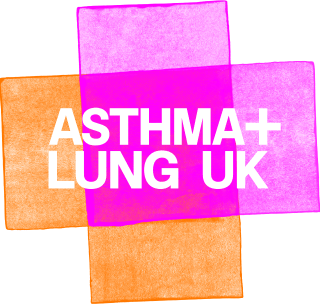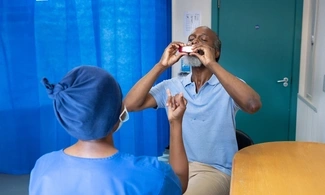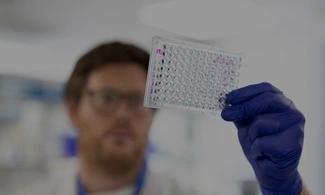Want to learn more about new treatments for bronchiectasis?
Our Research + Innovation team brings together researchers and people with bronchiectasis. By joining our Bronchiectasis Research Community, you can help shape the future of research into your condition, understand more about it, stay up to date on the latest research and be part of transforming lives.
Find out more about our Bronchiectasis Research Community.
Clearing your chest
Bronchiectasis causes phlegm (sputum) to build up in your airways. Learning how to clear this phlegm can help:
- control bronchiectasis symptoms like breathlessness, chest pain and coughing
- reduce your risk of getting infections
- increase your ability to stay active
- improve your general wellbeing.
Clearing your chest also helps some people with ‘dry bronchiectasis’, meaning you cough up little to no phlegm (sputum).
Airway clearance techniques for bronchiectasis
When you’re diagnosed with bronchiectasis, your GP should refer you to a specialist called a respiratory physiotherapist. They understand how your lungs and muscles work and know the best exercises to help with your breathing.
Your respiratory physiotherapist can teach you airway clearance techniques (ACTs). Do not try to do these exercises yourself without being shown by a respiratory physiotherapist first. If you do them incorrectly, it could damage your lungs.
Your respiratory physiotherapist will also support and help you to:
- Find the best and most effective airway clearance exercises for you.
- Get into a good ACT routine. Most people with bronchiectasis benefit from doing these exercises twice a day for 10 to 30 minutes, but you can work with your respiratory physiotherapist to find the right routine for you.
The most common technique used in the UK is the active cycle of breathing technique (ACBT). This technique involves changing your breathing and repeatedly coughing to bring up phlegm. University College London Hospital has a short and helpful video that explains more about ACBT.
Your respiratory physiotherapist might also teach you postural drainage. This is where you change position to clear phlegm from your chest.
Handheld devices to clear your chest
Handheld devices can help to clear your chest. These devices usually use a combination of vibrations and air pressure to help you cough up phlegm. Examples of these include Acapella, Aerobika or Flutter.
Speak to your respiratory physiotherapist about whether one of these devices could work for you, as they might not work for everybody.
Mucolytics
Mucolytics are medicines that can help you clear your chest. If you find it hard to bring up phlegm, your healthcare professional might recommend taking mucolytics.
The main mucolytics used to treat bronchiectasis in the UK include:
- Saltwater solution (saline). This is taken through a nebuliser. A nebuliser is a device that changes liquid medicine into fine mist for you to breather in through a face mask or mouthpiece.
- Carbocisteine. This comes as a capsule you swallow, or as a syrup or liquid you drink. You usually take it three to four times a day.
- Acetylcysteine. This comes as a powder or tablet that you mix with water and drink.
Antibiotics
Antibiotics are used to treat bronchiectasis flare-ups. A flare-up is when your usual symptoms get worse. The medical name for a flare-up is exacerbation.
If you have a flare-up caused by a bacterial infection, you’ll get a course of antibiotics. You’ll usually have to take these for 14 days.
Before prescribing antibiotics, your healthcare professional should take a sample of your phlegm (sputum). They should test this to check what’s causing your flare-up.
They can then prescribe antibiotics based on:
- the type of bacteria found in your phlegm (sputum)
- antibiotics that worked for you in the past.
Your healthcare professional might start your course of antibiotics without waiting for the results of your phlegm sample. Once they get the results, they might change your course of antibiotics if they need to.
Antibiotic resistance and side-effects
It’s important to finish your course of antibiotics even if you feel better, to make sure the bacteria are fully treated. Stopping early may mean your infection could come back.
We have more information about taking antibiotics, including antibiotic resistance and other side-effects.
Antibiotic rescue packs for bronchiectasis
Your healthcare professional might give you a short course of antibiotics to keep at home in case you have a flare-up. This is sometimes called a rescue pack.
Your healthcare professional should explain when and how to start them. You can put this information in your self-management plan. Usually, you should only start taking them if you have a sign of an infection, such as a change in colour or texture of your phlegm (sputum).
Always tell your healthcare professional if you use your rescue pack to treat a bronchiectasis flare-up. This is so they can review your treatment and see if you need any changes to your medicines.
Long-term antibiotics for bronchiectasis
If you’ve had three or more flare-ups in a year, your healthcare professional should refer you to a specialist. The specialist may suggest taking antibiotics long-term to see if this could help prevent future flare-ups. They might call these prophylactic antibiotics.
If the specialist prescribes you long-term antibiotics, they should:
- Prescribe antibiotics that are specific to you and what’s causing your flare-ups. You might not get the same antibiotics as somebody else.
- Explain how your antibiotics can work with your other medicines to reduce your risk of flare-ups.
- Talk to you about any risks or side-effects.
- Review your treatment regularly.
If you have a flare-up while using long-term antibiotics, you should stop taking them. Your healthcare professional can prescribe you different antibiotics to treat your flare-up. After you’ve recovered, they might consider changing the type of long-term antibiotics you’re using.
Bacterial colonisation
When you go for your annual bronchiectasis review, you should give your healthcare professional a phlegm (sputum) sample so they can check for bacteria.
Sometimes, people who have bronchiectasis have types of bacteria in their phlegm (sputum) that are more difficult to clear and might need different antibiotics. This is called bacterial colonisation. Your healthcare professional can explain this more and tell you if you need to use antibiotics to treat this.
Bacterial colonisation can happen with a lot of types of bacteria, for example Haemophilus influenzae, Moraxella catarrhalis, Pseudomonas and non-tuberculous mycobacterium (NTM).
Pulmonary rehabilitation
Pulmonary rehabilitation (PR) is an education and activity course designed for people living with lung conditions that make them breathless, including bronchiectasis. It includes:
- exercises to help you feel stronger and have more energy
- bronchiectasis support and advice to help you understand your condition
- lifestyle advice, for example help with healthy eating
- physical and emotional support.
We have more information about PR, including how to get a PR referral and its benefits.
We also have a Keep Active programme designed to help people with lung conditions. If you’re waiting for a PR course to start or want to keep up your activity levels after PR, this could work for you.
Vaccines
If you have bronchiectasis, getting vaccinated against respiratory infections can help you stay safe because respiratory infections can increase your chance of becoming seriously ill or needing to go to hospital. Getting the vaccines that you’re eligible for may also help prevent bronchiectasis flare-ups.
These vaccines are free for people with bronchiectasis:
If you’re aged 75 to 79 years old or are 28 weeks or more pregnant, you’re also eligible for an RSV vaccine.
Your friends, families or carers might be able to get some of these vaccines to help protect you too.
Inhalers
Inhalers are not always used as a treatment for bronchiectasis, but your healthcare professional may prescribe you an inhaler:
- if your bronchiectasis is making you very breathless every day
- to take before you do chest clearance
- if you also have asthma or COPD.
If you’re prescribed an inhaler for your bronchiectasis, it will have bronchodilator medicines in it. Bronchodilator medicines open your airways and relax the muscles in your chest. This makes it easier for you to breathe.
There are different types of bronchodilators used for bronchiectasis:
Reliever inhalers (short-acting bronchodilators)
Short-acting bronchodilators work in a few minutes to relax your muscles, open your airways and stop symptoms. You might call this your reliever or rescue inhaler.
You can use them up to four times a day. They can help your breathing for four to six hours.
Long-acting bronchodilators
You’ll usually need to take a long-acting bronchodilators inhaler once or twice a day. They can keep your airways open, helping your breathing, for between 12 to 24 hours.
Using your inhaler well
When your healthcare professional prescribes you an inhaler, they should check that you know how to use it well.
Using the correct inhaler technique is important because it means that you get the full benefit of your medicines. You can also speak to a pharmacist or use our short inhaler videos to check your technique.
There are also different types of inhaler devices available, and you might find some easier to use than others. Find out more about different types of inhalers and inhaler choices.
Treating other health conditions
A lot of people with bronchiectasis have one or more other long-term health condition. This is called a comorbidity.
Bronchiectasis comorbidities include:
- lung conditions, like asthma, COPD and pulmonary hypertension
- heart problems, like heart disease, high cholesterol and high blood pressure (hypertension)
- mental health conditions, like anxiety and depression
- thinning of the bones (osteoporosis)
- gastroesophageal reflux (GERD)
- chronic kidney disease
- liver disease
- diabetes
- stroke.
Getting the right treatment and support for any other long-term health conditions can help your bronchiectasis too.
Your healthcare professional can talk to you about how your treatments work together and how to manage multiple conditions at once. You could also speak to your pharmacist about how treatments and medicines for each of your conditions work together.
The British Heart Foundation has more advice about managing multiple health conditions.
Treatments for severe bronchiectasis
Surgery
A lobectomy is a surgical treatment for bronchiectasis.
Your lungs have five sections called lobes. In a lobectomy, the lobes of your lungs affected by bronchiectasis are removed.
Surgery is not often used to treat bronchiectasis. Only a small amount of people with bronchiectasis will benefit from surgery.
Embolisation
If your bronchiectasis means you cough up a lot of blood, you need to get medical attention.
A special CT scan may be done to find the source of bleeding in your lungs.
Sometimes, the bleeding can be stopped using a procedure called a bronchial artery embolisation. This is when your healthcare professionals find the source of your bleeding and then inject tiny particles into your blood vessels to stop it.
Lung transplant
During a lung transplant, one or both of your lungs are removed and replaced with a lung or pair of lungs from a donor. Lung transplants for people with bronchiectasis are rare and are only carried out when all other treatments are not working.
The NHS has more information about lung transplants.
Oxygen therapy
Most people with bronchiectasis do not need oxygen therapy. However, if your oxygen levels are very low you may need to breathe in oxygen through a tube or mask.
We have more advice about oxygen therapy.

Get support
Our helpline is closed from 1pm on Wednesday 24th December 2025 and re-opens at 9:15am on Friday January 2nd 2026. Our supporter care line is also unavailable during this period. If you have a flare-up of your lung condition symptoms, contact your GP or healthcare professional or 111 for advice. Always dial 999 in an emergency.








